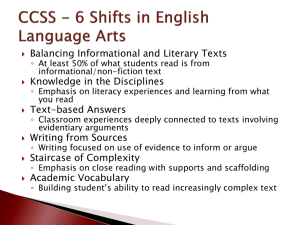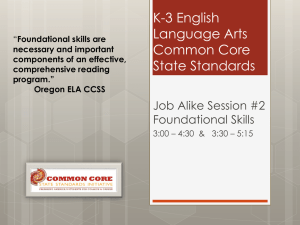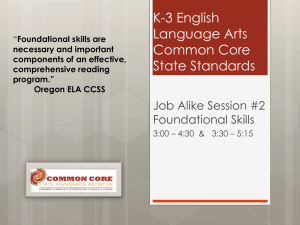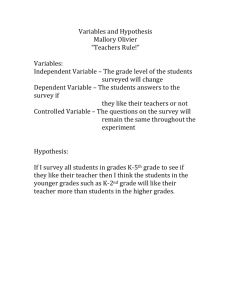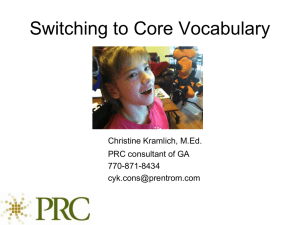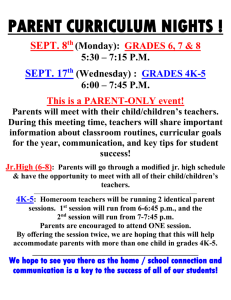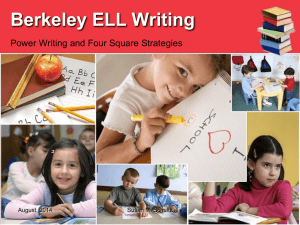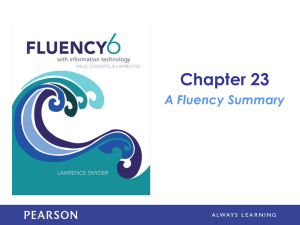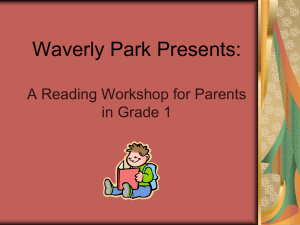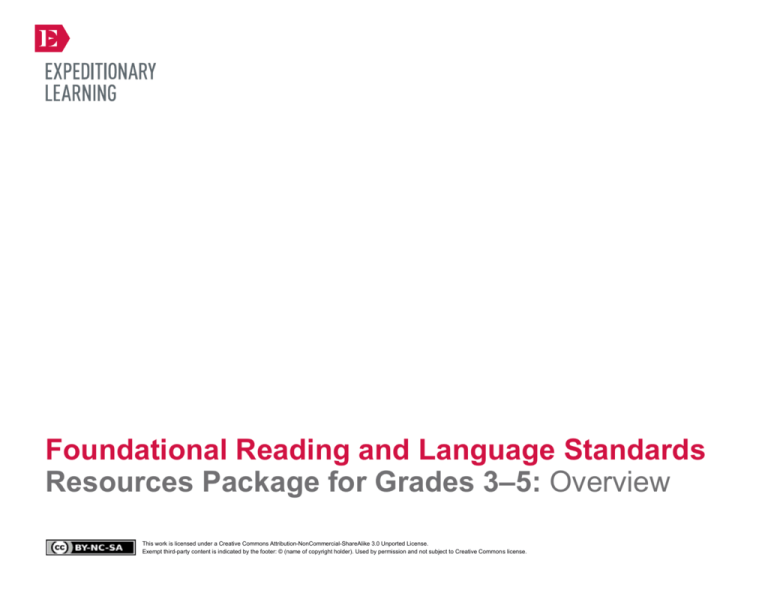
Foundational Reading and Language Standards
Resources Package for Grades 3–5: Overview
This work is licensed under a Creative Commons Attribution-NonCommercial-ShareAlike 3.0 Unported License.
Exempt third-party content is indicated by the footer: © (name of copyright holder). Used by permission and not subject to Creative Commons license.
FOUNDATIONAL READING AND LANGUAGE STANDARDS
Resources Package for Grades 3-5
Overview
The New York State Common Core–aligned ELA modules for grades 3–5 were designed to help teachers build students’ capacity to read, think, talk, and write about
complex texts. The modules fully address the reading standards for both literary and informational texts, the writing standards, and the speaking and listening standards.
Foundational reading and language also are addressed within the context of the module lessons; these standards are more heavily emphasized in specific module lessons
within Module 2B.
However, the 60-minute module lessons alone do not represent enough time to comprehensively meet the Foundational reading and language standards. To ensure that
students receive adequate support building foundational reading and language skills, as well as sufficient time to meet the volume of reading required by the CCSS, research
suggests that an additional block of literacy instruction and skills practice is needed.
This Foundational Reading and Language Standards Resources Package for Grades 3–5 is designed with three purposes: to articulate the research base for instruction
regarding reading foundations standards; to point teachers to where that instruction lives “within the modules”; and, most important, to offer teachers options about how
to organize an additional literacy block to comprehensively address these standards beyond and alongside the module lessons.
Literacy instruction that occurs alongside the modules ideally is complementary to the reading, writing, speaking, and listening that students engage in during the 60minute module lessons. Research suggests that students benefit from additional time spent on literacy skills instruction with differentiated support, so they can continue to
acquire and practice the skills necessary in becoming proficient and independent readers, writers, speakers, and listeners. There are various ways to organize this time so
teachers can pull small, guided groups and provide additional whole-class instruction on discrete skills, as deemed necessary by formative reading and writing assessments.
This package contains resources and guidance for providing foundational reading and language instruction alongside the module lessons. In this overview, you will find:
• Resources Package At-A-Glance: a visual representation and written description of the resources in this package
• Research Base: a research review, implications for instruction, and associated resources for each aspect of foundational reading and language standards instruction
• Sample Schedule: a sample two-week alternating schedule that outlines one way to organize a foundational reading and language instructional block
• RF and L Standards within the Module Lessons: a list of examples of foundational reading and language instruction in the 60-minute module lessons, by grade
• References: citations for those who would like to do further study
Copyright © 2013 by Expeditionary Learning, New York, NY. All Rights Reserved.
NYS Common Core ELA Curriculum • Resources Package for Grades 3-5: Overview • December 2013•
1
FOUNDATIONAL READING AND LANGUAGE STANDARDS
Resources Package for Grades 3-5
Overview
Foundational Reading and Language Resources
Package
Overview
Includes a description of the resources in this package,
the research base, a sample schedule, and a list of
examples within the 60-minute module lessons.
Word Study Criteria
Suggestions and
specific criteria for
approaches to word
work that teach
phonics and word
analysis.
Additional Work with
Complex Texts
Guidance for providing
additional support
with complex texts
from the module
lessons.
Core Knowledge
Skills Strand
(Grade 3 only)
Structured phonics and fluency
assessments and lessons for
students with some gaps in
their foundational reading
skills.
Copyright © 2013 by Expeditionary Learning, New York, NY. All Rights Reserved.
Fluency Resource
Resources and
guidance for
fluency
instruction.
Show the Rule™
Strategy
Resources and
guidance for
contextualized
grammar and
conventions
instruction.
Independent Reading:
Sample Plan and The
Importance of a Volume
of Reading
Resources and
guidance for
launching
independent reading
to ensure an
appropriate volume
of reading and the
importantce of a
volume of reading.
NYS Common Core ELA Curriculum • Resources Package for Grades 3-5: Overview • December 2013•
2
FOUNDATIONAL READING AND LANGUAGE STANDARDS
Resources Package for Grades 3-5
Overview
Research Base
Phonics and Word Recognition (CCSS RF.3)
As students in the intermediate grades become comfortable with the basic mechanics of reading and gain automaticity, they must continue to hone their skills as fluent and
facile readers in order to comprehend the text they read. Although discrete phonics instruction is an important component of early literacy instruction (National Reading
Panel, 2000), readers in intermediate grades benefit from a more contextualized approach to teaching phonics and word recognition (Bear, Invernizzi, Templeton, &
Johnston, 2003; Bloodgood & Pacifici, 2004). Phonics instruction in the intermediate grades focuses on the morphology of words (affixes and roots), syllabication patterns,
and more complex spelling patterns. This transition is reflected in the third-grade foundational reading standard RF.3, decoding with common Latin suffixes and use of
syllabication to read unfamiliar words.
Research suggests that as much as possible, this instruction should take place in the context of the texts that students are reading, as this supports them in decoding and
inferring the meaning of unfamiliar vocabulary. These word analysis skills are key in acquiring core academic vocabulary and ultimately in understanding the complex texts
that students encounter as they enter the intermediate elementary grades (Blevins & Lynch, 2001; Hiebert, 2012; Juel & Deffes, 2004).
The 60-minute module lessons provide some contextualized instruction of phonics and word analysis, specifically during lessons that involve close reading. However, to
ensure that students have the foundational skills necessary to build toward college and career readiness, they will need more support and practice with these skills during
additional literacy instruction that occurs alongside the modules. This instruction may be presented to the whole class but often takes place in small, differentiated groups
where students can practice word analysis in the context of the complex texts they are reading in the modules, other independent-level texts, and during word study games
and activities. The resources contained in this package provide examples, guidance, and materials to help teachers envision options for organizing the instruction of phonics
and word analysis in grades 3–5.
See the following components of this resources package:
• Word Study Criteria
• Additional Work with Complex Texts
• Independent Reading: The Importance of a Volume of Reading and Sample Plans
• Core Knowledge Skills Strand (Grade 3 only): As recommended by NYSED, a resource developed by Core Knowledge for explicit structured phonics and fluency
instruction for students in the third grade who need additional support learning and practicing decoding skills (Note- This is not for students who are far below grade
level. These students should receive more intensive and individualized support). Use the following link to access Core Knowledge’s Skills Strand:
www.coreknowledge.org/ckla-files.
Copyright © 2013 by Expeditionary Learning, New York, NY. All Rights Reserved.
NYS Common Core ELA Curriculum • Resources Package for Grades 3-5: Overview • December 2013•
3
FOUNDATIONAL READING AND LANGUAGE STANDARDS
Resources Package for Grades 3-5
Overview
Research Base
Fluency (CCSS RF.4)
Reading fluency is the ability to read accurately, automatically, and with proper phrasing and intonation so that a reader is able to make meaning of a text, whether it is
read silently or orally (Kuhn, 2010). Recent research shows that the role of fluency is even more important to reading comprehension than once thought (Rasinski, 2004).
When students read with automaticity, the ability to recognize and read words without conscious thought, they are able to devote all of their energy to comprehending the
meaning as opposed to decoding the words. In addition, students must master the ability to read with proper phrasing and intonation, or prosody (Rasinski, 2006). This
means that fluent readers read the words without effort and also attend to syntax, or the structure of sentences and their punctuation when reading. In order to read and
comprehend complex texts, students not only have to decode and make meaning of difficult vocabulary, but they must also be able to read more complicated sentence
structures. Although being fluent readers alone will not guarantee comprehension, it is another vitally important skill students need to become proficient and independent
readers of complex texts.
Teachers already know a great deal about fluency instruction. Good fluency instruction includes read-alouds that model fluent and expressive reading, regular and repeated
silent and oral reading of texts in the grade-level band of complexity and at students’ independent reading levels, and opportunities for self-assessment as well as teacher
and peer feedback (Rasinski, 2006).
See the following components of this resource package:
• Fluency Resource
• Independent Reading: The Importance of a Volume of Reading and Sample Plans
• Core Knowledge Skills Strand (Grade 3 only): As recommended by NYSED, a resource developed by Core Knowledge for explicit structured phonics and fluency
instruction for students in the third grade who need additional support learning and practicing decoding skills (Note- This is not for students who are far below grade
level. These students should receive more intensive and individualized support). Use the following link to access Core Knowledge’s Skills Strand:
www.coreknowledge.org/ckla-files.
Conventions of Standard English and Knowledge of Language (CCSS L.1, L.2, and L.3)
Research shows that conventions and grammar are best taught within the context of authentic reading and writing tasks (Weaver & Bush, 2008). Students benefit from
proactive instruction that uses models of informational texts and literature to teach explicit conventions and grammatical rules that can then be applied in their writing
(Weaver, McNally, & Moerman, 2001). Teachers can plan these lessons based on the specific grade-level demands of the CCSS and on the analysis of student work.
Students also benefit from instruction later in the writing process that includes targeted mini lessons that support students in revising their work (e.g., the teacher notices
common errors and provides targeted teaching or re-teaching). As students prepare to publish their work, one option is for teachers to support students in peer editing for
these rules in order to reinforce this learning. In this way, students can see the value and practical application of rules of convention and grammar within the context of
mentor texts, their own work, and their peers’ work.
Copyright © 2013 by Expeditionary Learning, New York, NY. All Rights Reserved.
NYS Common Core ELA Curriculum • Resources Package for Grades 3-5: Overview • December 2013•
4
FOUNDATIONAL READING AND LANGUAGE STANDARDS
Resources Package for Grades 3-5
Overview
Research Base
Many of the language standards are addressed during the writing process in the modules (most heavily emphasized in Unit 3 of every module). However, the modules do
not represent a comprehensive teaching and assessment of these standards. The resources contained in this package provide examples, guidance, and materials to draw on
in order to teach the conventions of standard English and knowledge of language standards in grades 3–5.
See the following components of this resources package:
• Show the Rule™ Strategy
Vocabulary Acquisition and Use (CCSS L.4, L.5, and L.6)
The importance of vocabulary instruction is evident in the number of CCSS ELA standards that are related to vocabulary. This emphasis on building word knowledge, as
well as developing strategies to determine the meaning of unknown words, is woven throughout the language standards and in both literary and informational reading
standards. This repetition of vocabulary in the standards is no accident. Several decades of research make a strong case for frequent and explicit vocabulary instruction
(Liben, 2010). Research shows that deficiencies in working vocabulary (words students use when speaking and writing and understand when listening and reading) are a
primary factor in the achievement gap (Beck & McKeown, 2007). Furthermore, students’ vocabulary deficiencies are highly correlated with difficulties in reading
comprehension (Biemiller, 2001).
Effective vocabulary instruction includes direct systematic instruction, as well as teaching students strategies for making meaning of unfamiliar words on their own. It also
requires students to read a sufficient amount of complex text and informational text, so they are exposed to academic and domain specific vocabulary in a variety of
contexts. (Liben, 2010).
The 60-minute module lessons provide a comprehensive approach to vocabulary instruction that includes direct instruction using complex texts, a variety of protocols that
allow students to analyze and make meaning of new vocabulary, and strategies for supporting students in determining the meaning of new vocabulary and using these
words in their own writing. This instruction takes place in every module, with focused vocabulary work (aligned with CCSS L.4, L.5, and L.6) showing up in many specific
lessons.
Therefore, this resources package does not contain additional materials directly tied to the teaching of Language Standards 4-6. However, teachers may wish to regularly
incorporate additional vocabulary instruction into their class instruction and small group work.
Copyright © 2013 by Expeditionary Learning, New York, NY. All Rights Reserved.
NYS Common Core ELA Curriculum • Resources Package for Grades 3-5: Overview • December 2013•
5
FOUNDATIONAL READING AND LANGUAGE STANDARDS
Resources Package for Grades 3-5
Overview
Sample Schedule, Week A
This schedule represents one possible way to organize a foundational reading and language instructional block. It is a two-week alternating schedule featuring both smallguided groups and independent center work that focuses on the foundational reading and language skills standards. The schedule below represents week A in this two-week
cycle.
Note that the schedule itself simply shows how time is allocated to address various skills. For the skill named in each box, refer to the corresponding resource that is a part
of this full package (e.g., the Fluency Resource). Each of those documents provides details regarding the specific instructional practices that should take place during this
block of time. Teachers might use this schedule to extend existing practices that are already in place (such as independent reading) and to enhance with new center work.
Additional Literacy Block
WEEK A
45–60 minutes per day + 15-minute daily homework assignment; three differentiated groups rotate through each center outlined below.
Approx.
time
Mon
Full Class
Tues
Centers—small rotating
groups
Wed
Centers—small rotating
groups
Thurs
Centers—small rotating
groups
Fri
Full class
15- or 20min. block
Show the Rule
Full-class teacher-led
introduction
Fluency ResourceModeling and
Assistance (rotating
center; teacher-led)
Additional work with
Complex Texts
(rotating center; teacherled)
Additional work with
Complex Texts
(rotating center; teacherled)
Fluency ResourcePractice and Assistance
(partner work; informal
assessment by teacher)
Additional work with
Complex Texts
(rotating center)
Show the Rule
(rotating center)
Independent Reading
(rotating center)
Additional work with
Complex Texts
(small group/pairs; informal
assessment by teacher)
Show the Rule
(rotating center)
Fluency ResourceAssistance
(partner work; rotating
center)
Show the Rule
(rotating center)
Show the Rule
(pair share; assessment)
Fluency ResourcePractice
Independent Reading
Fluency ResourcePractice
Independent Reading
15- or 20min. block
15- or 20min. block
15 minutes
Independent Reading
(individual conferences with
teacher)
HOMEWORK
Independent Reading
Sample Schedule, Week B
Copyright © 2013 by Expeditionary Learning, New York, NY. All Rights Reserved.
NYS Common Core ELA Curriculum • Resources Package for Grades 3-5: Overview • December 2013•
6
FOUNDATIONAL READING AND LANGUAGE STANDARDS
Resources Package for Grades 3-5
Overview
This schedule represents one possible way to organize a foundational reading and language instructional block. It is a two-week alternating schedule featuring both smallguided groups and independent center work that focuses on the foundational reading and language skills standards. The schedule below represents week B in this two-week
cycle.
Note that the schedule itself simply shows how time is allocated to address various skills. For the skill named in each box, refer to the corresponding resource that is a part
of this full package (e.g., the Fluency Resource). Each of those documents provides details regarding the specific instructional practices that should take place during this
block of time. Teachers might use this schedule to extend existing practices that are already in place (such as independent reading) and to enhance with new center work.
Additional Literacy Block
WEEK B
45–60 minutes per day + 15-minute daily homework assignment; three differentiated groups rotate through each center outlined below.
Approx.
time
Mon
Centers—small rotating
groups
Tues
Centers—small rotating
groups
Wed
Centers—small rotating
groups
Thurs
Centers—small rotating
groups
Fri
Full class
15- or 20min. block
Word Study
(rotating center; teacherled)
Additional Work with
Complex Texts
(rotating center; teacherled)
Fluency ResourceModeling and Assistance
(rotating center; teacher-led)
Additional Work with
Complex Texts
(rotating center; teacherled)
Fluency ResourcePerformance
(full class; teacherfacilitated)
15- or 20min. block
Additional Work with
Complex Texts
(rotating center)
Independent Reading
(rotating center)
Word Study
(rotating center)
Independent Reading
(rotating center)
Word StudyAssessment
(small groups—teacher-led)
15- or 20min. block
Fluency ResourcePractice
(rotating center)
Word Study
(rotating center)
Additional Work with
Complex Texts
(rotating center)
Word Study
(rotating center)
Independent Reading
(remainder of class—while
teacher pulls groups for
Word Study assessment)
HOMEWORK
15 minutes
Independent Reading
Fluency ResourcePractice
Copyright © 2013 by Expeditionary Learning, New York, NY. All Rights Reserved.
Independent Reading
Fluency 0ResourcePractice
Independent Reading
NYS Common Core ELA Curriculum • Resources Package for Grades 3-5: Overview • December 2013•
7
FOUNDATIONAL READING AND LANGUAGE STANDARDS
Resources Package for Grades 3-5
Overview
RF and L Standards within the Module Lessons
Examples of foundational reading and language instruction in the module lessons grade by grade
Standards
Grade 3
Grade 4
Grade 5
RF.3 Phonics and Word Recognition
Know and apply grade-level phonics and word analysis skills in decoding words.
Module 2B, Unit 2, Lesson 9
Module 2B, Unit 2, Lesson 10
Module 2B, Unit 2, Lesson 11
Module 2B, Unit 1, Lesson 3
Module 2B, Unit 2, Lesson 6
Module 2B, Unit 2, Lesson 7
RF.4 Fluency
Read with sufficient accuracy and fluency to support comprehension.
Module 2B, Unit 2, Lesson 1,
Module 3A, Unit 2, Lesson 12
Module 3A, Unit 1, Lesson 4
Module 2B, Unit 2, Lesson 6
Module 2B, Unit 2, Lesson 7
L.1 Conventions of Standard English
Demonstrate command of the conventions of standard English grammar and usage
when writing or speaking.
Module 2B, Unit 3, Lesson 9
Module 2B, Unit 2, Lesson 11
Module 3A, Unit 3, Lesson 12
Module 4, Unit 3, Lesson 13
L.2 Conventions of Standard English
Demonstrate command of the conventions of standard English capitalization,
punctuation, and spelling when writing.
Module 2B, Unit 1, Lesson 15
Module 2B, Unit 3, Lesson 9
Module 3A, Unit 2, Lesson 10
Module 2B, Unit 2, Lesson 11
Module 2B, Unit 3, Lesson 9
Module 2B, Unit 3, Lesson 12
Module 4, Unit 3, Lesson 11
L.3 Knowledge of Language
Use knowledge of language and its conventions when writing, speaking, reading, or
listening.
Module 2B, Unit 1, Lesson 15
Module 2B, Unit 3, Lesson 1
Module 2B, Unit 3, Lesson 8
Module 2B, Unit 3, Lesson 9
Module 2A, Unit 3, Lesson 14
Module 2B, Unit 3, Lesson 10
Module 3A, Unit 3, Lesson 13
Module 2B, Unit 3, Lesson 6
Module 2B, Unit 3, Lesson 11
Module 4, Unit 3, Lesson 14
L.4 Vocabulary Acquisition and Use
Determine or clarify the meaning of unknown and multiple-meaning words and
phrases based on grade-level reading and content, choosing flexibly from a range of
strategies.
Module 2B, Unit 1, Lesson 3
Module 2A, Unit 1, Lesson 3
Module 2B, Unit 1, Lesson 3
Module 2B, Unit 1, Lesson 2
Module 2B, Unit 1, Lesson 3
Module 2B, Unit 1, Lesson 4
L.5 Vocabulary Acquisition and Use
Grade 3: Demonstrate understanding of word relationships and nuances in word
meanings.
Grades 4 and 5: Demonstrate understanding of figurative language, word
relationships, and nuances in word meanings.
Module 2B, Unit 2, Lesson 9
Module 3A, Unit 2, Lesson 2
Module 4, Unit 2, Lesson 4
Module 3B, Unit 1, Lesson 7
Module 4, Unit 2, Lesson 4
Module 4, Unit 2, Lesson 6
L.6 Vocabulary Acquisition and Use
Acquire and use accurately grade-appropriate conversational, general academic, and
domain-specific words and phrases.
Module 1, Unit 2, Lesson 7
Module 2B, Unit 3, Lesson 10
Module 2B, Unit 2, Lesson 7
Module 2B, Unit 2, Lesson 8
Copyright © 2013 by Expeditionary Learning, New York, NY. All Rights Reserved.
NYS Common Core ELA Curriculum • Resources Package for Grades 3-5: Overview • December 2013•
8
FOUNDATIONAL READING AND LANGUAGE STANDARDS
Resources Package for Grades 3-5
Overview
References
Adams, M. (2010–2011). Advancing Our Students’ Language and Literacy: The Challenge of Complex Text. American Educator, 3–11.
Allington, R. L. (1983). Fluency: The neglected goal of the reading program. The Reading Teacher, 36, 556–561.
Bear, D., Invernizzi, M., Templeton, S., and Jonston, F. (2000). Words their way: word study for phonics, vocabulary, and spelling instruction (2nd ed.). Englewood
Cliffs, NJ: Prentice Hall.
Beck, I. L., & McKeown, M. G. (2007). Increasing young low-income children's oral vocabulary repertoires through rich and focused instruction. The Elementary School
Journal, 107(3), 251–271.
Biemiller, A. (2001). Teaching Vocabulary: Early, Direct, and Sequential. American Educator.
Blevins, W. (2001). Teaching Phonics and Word Study in the Intermediate Grades. New York: Scholastic.
Bloodgood, J. W. and Pacifici, L. C. (2004). Bringing word study to intermediate classrooms. The Reading Teacher, 58(3), 250–263.
Cunningham, A. and Stanovich, K. (1998). American Educator/American Federation of Teachers, Spring/Summer, 1–7.
Hasbrouck, J. (2006). For Students Who Are Not Yet Fluent, Silent Reading Is Not the Best Use of Classroom Time. American Educator, 30(2).
Hiebert, E. H. (2012). Core Vocabulary: The Foundation for Successful Reading of Complex Text. Text Matters. Text Project, Inc.
Juel, C. and Deffes, R. (March 2004). Making Words Stick. Educational Leadership, 61(6).
Kuhn, M. R., Schwanenflugel, P. J., and Meisinger, E. B. (2010). Aligning Theory and Assessment of Reading Fluency: Automaticity, Prosody, and Definitions of Fluency.
Reading Research Quarterly, 45(2), 230–251.
Learning First Alliance. The Content of Professional Development. (November 2000). Every Child Reading: A Professional Development Guide.
Copyright © 2013 by Expeditionary Learning, New York, NY. All Rights Reserved.
NYS Common Core ELA Curriculum • Resources Package for Grades 3-5: Overview • December 2013•
9
FOUNDATIONAL READING AND LANGUAGE STANDARDS
Resources Package for Grades 3-5
Overview
References
Liben, David (2010). “Why text complexity matters” in Common core state standards for English language arts and literacy in history/social studies, science, and technical
subjects. Appendix A: Research supporting key elements of the standards. National Governors Association Center for Best Practices, Council of Chief State School
Officers: Washington, D.C.
Liben, D. (March 2010). Aspects of Text Complexity: Vocabulary Research Base. http://www.quia.com/files/quia/users/esol9817/AA/Academic_Vocabulary_.
Meyer, M. S. and Felton, R. H. (1999). Repeated reading to enhance fluency: Old approaches and new directions. Annals of Dyslexia, 49, 283–306.
National Reading Panel (2000). Report of the National Reading Panel: Teaching children to read. Bethesda, MD: National Institute of Child Health and Human
Development.
Rasinski, Tim (March 2004). Creating Fluent Readers. Educational Leadership, 61(6).
Rasinski, Tim (April 2006). Reading fluency instruction: Moving beyond accuracy, automaticity, and prosody. The Reading Teacher, 59(7), 704–706.
Weaver, C. and Bush, J. (2008). Grammar to Enrich and Enhance Writing. Portsmouth, NH: Heinemann.
Weaver, C., McNally, C., & Moerman, S. (March 2001). To Grammar or Not to Grammar: That is Not the Question! Voices from the Middle, 8(3).
Wolf, M. (2013). New Research on an Old Problem: A Brief History of Fluency. http://www.scholastic.com/teachers/article/new-research-old-problem-brief-historyfluency.
Copyright © 2013 by Expeditionary Learning, New York, NY. All Rights Reserved.
NYS Common Core ELA Curriculum • Resources Package for Grades 3-5: Overview • December 2013•
10

